- Latest Version 1.128
- Version 1.126
- SAPUI Version 1.124
- SAPUI5 Version 1.122
- SAPUI5 Version 1.118
- SAPUI5 Version 1.116
- SAPUI5 Version 1.114
- SAPUI5 Version 1.112
- SAPUI5 Version 1.110
- SAPUI5 Version 1.108
- SAPUI5 Version 1.106
- SAPUI5 Version 1.104
- SAPUI5 Version 1.102
- SAPUI5 Version 1.100
- SAPUI5 Version 1.98
- SAPUI5 Version 1.96
- SAPUI5 Version 1.94
- SAPUI5 Version 1.92
- SAPUI5 Version 1.90
- SAPUI5 Version 1.88
- SAPUI5 Version 1.86
- SAPUI5 Version 1.84
- SAPUI5 Version 1.82
- SAPUI5 Version 1.80
- SAPUI5 Version 1.78
- SAPUI5 Version 1.76
- SAPUI5 Version 1.74
- SAPUI5 Version 1.72
- SAPUI5 Version 1.70
- SAPUI5 Version 1.68
- SAPUI5 Version 1.66
- SAPUI5 Version 1.64
- SAPUI5 Version 1.62
- SAPUI5 Version 1.60
- SAPUI5 Version 1.58
- SAPUI5 Version 1.56
- SAPUI5 Version 1.54
- SAPUI5 Version 1.52
- SAPUI5 Version 1.50
- SAPUI5 Version 1.48
- SAPUI5 Version 1.46
- SAPUI5 Version 1.44
- SAPUI5 Version 1.42
- SAPUI5 Version 1.40
- SAPUI5 Version 1.38
- SAPUI5 Version 1.36
- SAPUI5 Version 1.34
- SAPUI5 Version 1.32
- SAPUI5 Version 1.30
- SAPUI5 Version 1.28
- SAPUI5 Version 1.26
- Latest Version 1.128
- Version 1.126
- SAPUI Version 1.124
- SAPUI5 Version 1.122
- SAPUI5 Version 1.120
- SAPUI5 Version 1.118
- SAPUI5 Version 1.116
- SAPUI5 Version 1.114
- SAPUI5 Version 1.112
- SAPUI5 Version 1.110
- SAPUI5 Version 1.108
- SAPUI5 Version 1.106
- SAPUI5 Version 1.104
- SAPUI5 Version 1.102
- SAPUI5 Version 1.100
- SAPUI5 Version 1.98
- SAPUI5 Version 1.96
- SAPUI5 Version 1.94
- SAPUI5 Version 1.92
- SAPUI5 Version 1.90
- SAPUI5 Version 1.88
- SAPUI5 Version 1.86
- SAPUI5 Version 1.84
- SAPUI5 Version 1.82
- SAPUI5 Version 1.80
- SAPUI5 Version 1.78
- SAPUI5 Version 1.76
- SAPUI5 Version 1.74
- SAPUI5 Version 1.72
- SAPUI5 Version 1.70
- SAPUI5 Version 1.68
- SAPUI5 Version 1.66
- SAPUI5 Version 1.64
- SAPUI5 Version 1.62
- SAPUI5 Version 1.60
- SAPUI5 Version 1.58
- SAPUI5 Version 1.56
- SAPUI5 Version 1.54
- SAPUI5 Version 1.52
- SAPUI5 Version 1.50
- SAPUI5 Version 1.48
- SAPUI5 Version 1.46
- SAPUI5 Version 1.44
- SAPUI5 Version 1.42
- SAPUI5 Version 1.40
- SAPUI5 Version 1.38
- SAPUI5 Version 1.36
- SAPUI5 Version 1.34
- SAPUI5 Version 1.32
- SAPUI5 Version 1.30
- SAPUI5 Version 1.28
- SAPUI5 Version 1.26
Message Handling – Processing Multiple Items
Intro
When a user selects multiple items from a table, it might not be possible to process all of the items at once.
Users therefore need clear and user-friendly information on:
- The actions available for the selected items
- Any issues that prevent items from being processed
- Whether or not an action was successful for all items
Scenarios for Processing Results
This guideline outlines the message patterns and recommended message texts for the following scenarios:
- Success: All items were processed successfully
- Failure: No items can be processed / were processed
- Partial Processing: Only some items can be processed. Others can’t be processed or require manual validation.
Enabling/Disabling Actions
Success
When all items were processed successfully, show a message toast.
| Message Toast | |
| Text | <number of items> <item name> were <action>. |
Failure Cases
No items can be processed
When no items can be processed, disable the action button.
For example, if all the selected items are locked, disable the Edit button.
To help users understand why the action button is disabled, use the item states.
No items were processed
When no items were processed, show a message view in a dialog.
| Message View | |
| Header | Summary |
| First List Item | No <item names> were <action>. |
| Next List Items | Specific messages for each unprocessed item. |
| Button | Close |
Partial Processing
Backend issues
When one or more of the selected items were processed successfully and one or more were not, due to backend issues, show a message view in a dialog.
| Message View | |
| Header | Summary |
| First List Item | Success Message <number of successful items> of <total number of items> <item name> were <action>. |
| Next List Items |
|
| Button | Close |
One or more items can’t be processed
- Before processing, a warning message asks users whether they want to apply the action to remaining items.
- After user confirmation the resulting message depends on the processing results:
- A message toast for successful processing
- A message view for when backend errors occurred during the processing
Before Processing
If the action cannot be applied to one or more items, a warning message asks the users whether they want to apply the action to the other items.
| Warning Message Box | |
| Message Text | <number of items ineligible for the action> of <total number of items> <item name> can’t be <action>.
Do you still want to <action> the remaining <number of editable items> <item name>? |
| Message Details | Possible Causes Selected <item names> are excluded if:
|
| Buttons | <Primary action>, Cancel |
After User Confirmation
After the users confirm the primary action for the remaining items the resulting message depends on the processing results:
- When all the remaining items were successfully processed, a message toast is displayed.
- When one or more backend errors occurred during the processing, a Summary message view in a dialog is displayed. It includes:
- Successfully processed items
- The backend error or errors
- An information message for each item excluded from the processing
Information message text: The <item name> can’t be <action>
Processing is blocked by items that require manual validation
Some warnings for individual items may require a user decision before processing can continue:
- Case 1: Just one warning. The user can ignore the warning and process the item, or skip the item.
- Case 2: More than one warning. The user can ignore the warnings and process all the items, or skip all the affected items. Processing is only interrupted once.
Case 1: One Item
When one item requires manual validation, show a warning message box with actions to:
- Validate and process the item
- Skip the item: When the users skip the item, in the message view in a dialog, show an information message for the skipped item in the message view.
| Warning Message Box | |
| Body Text | <item name> <item ID>: <message description>
You can <action> this <item name> anyway, or skip it for now. |
| Show Details | Optional |
| Buttons | <Primary action>, Skip |
For the skipped item, in the Summary message view, add an information message text below the other (success, error, and warning) items.
| Message View | |
| Information Message Text | The <item name> was skipped and not <action>. |
Case 2: More than One
When more than one item requires manual validation, show a warning message box with actions to:
- Validate and process the items
- Skip the items: When the users skip the items, in the message view in a dialog, show an information message for each skipped item.
| Warning Message View | |
| Header | Warning |
| Body Text | Warnings exist for some of the selected <item name, plural>.
You can choose “<primary action>” to ignore the warnings, or skip these <item name, plural> for now. |
| Buttons | <Primary action>, Skip |
For each skipped item, in the Summary message view, add an information message text below the other (success, error, and warning) items.
| Message View | |
| Information Message Text | The <item name> was skipped and not <action>. |
Action on multiple items with field issues in edit mode
Triggering a mass action can reveal field issues because the mass action also triggers field validation.
List the field related messages among other messages in the summary message view dialog.
Once the dialog is closed, the message popover appears, with a list of only the field issues.
Related Links
Elements and Controls
- Message Box (guidelines)
- Message Popover (guidelines)
- Message view (guidelines)
- Message Toast (guidelines)

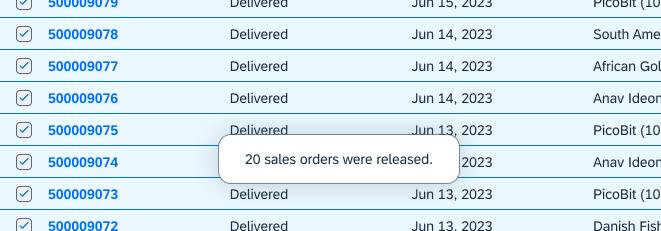
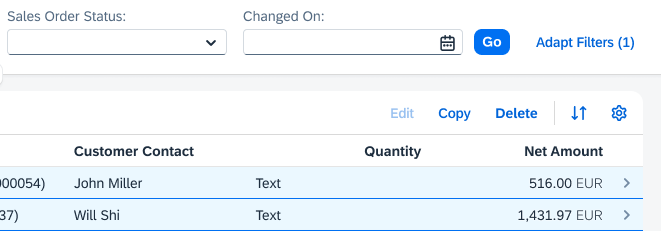
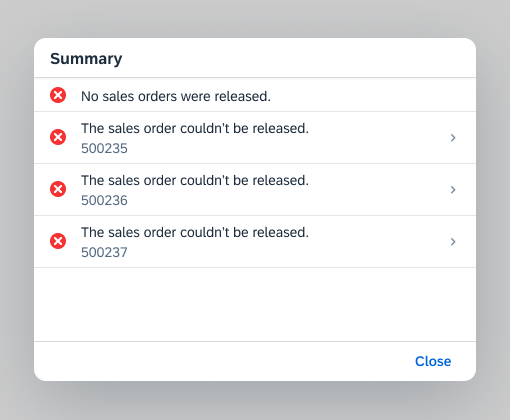
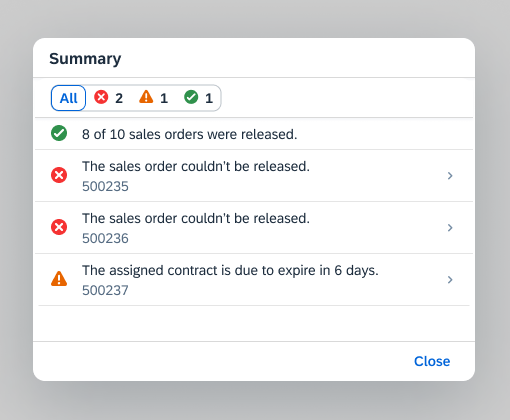
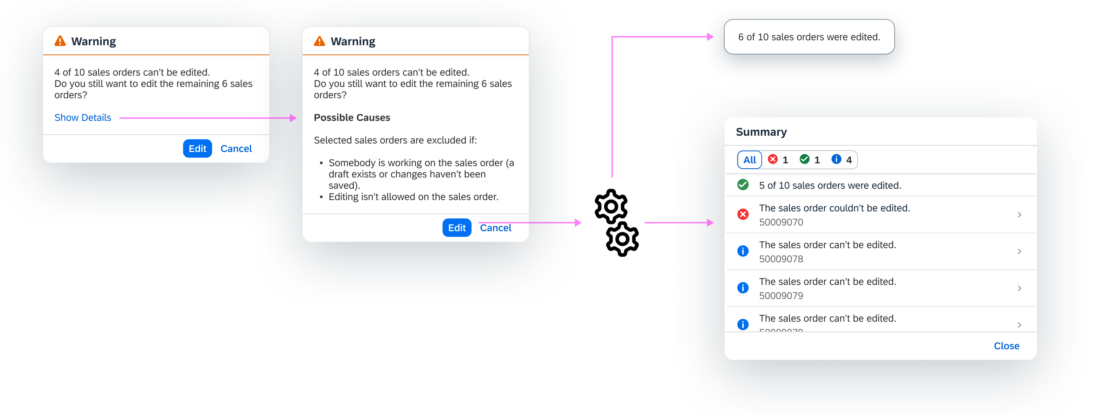
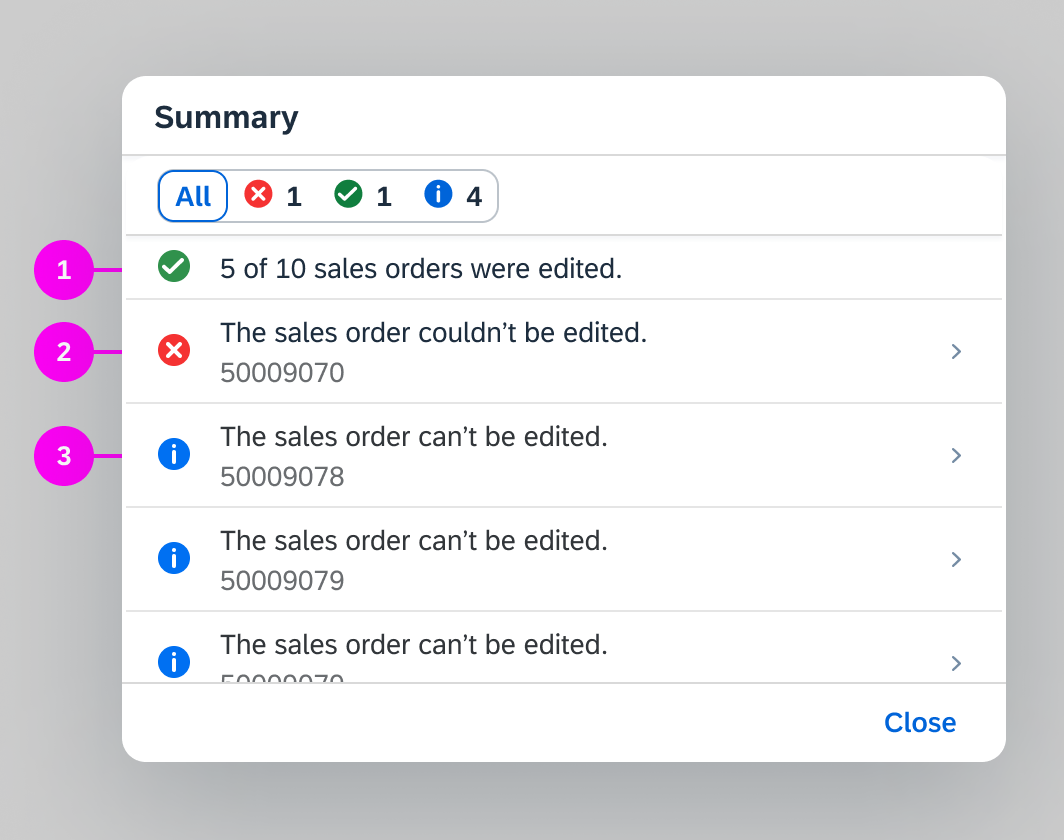
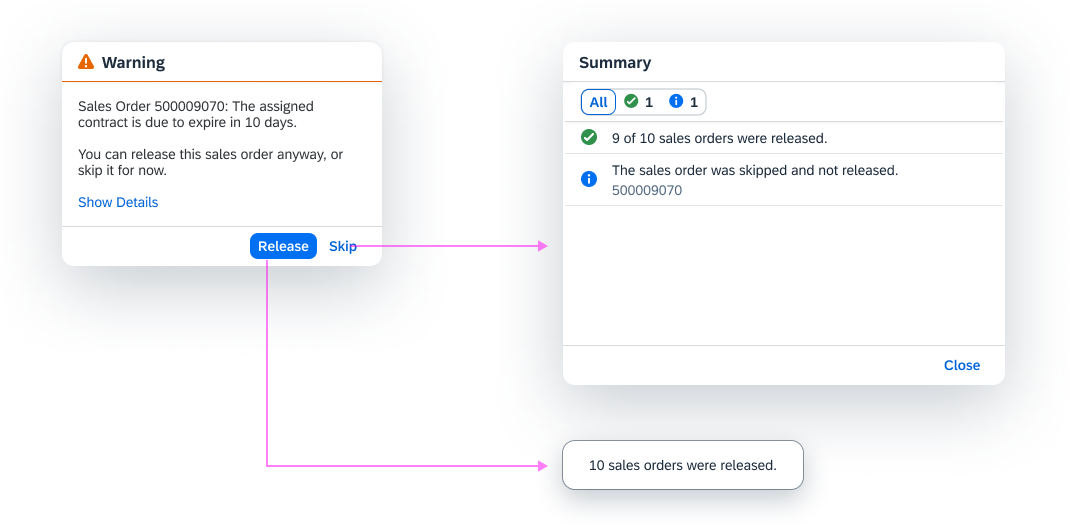


 Your feedback has been sent to the SAP Fiori design team.
Your feedback has been sent to the SAP Fiori design team.